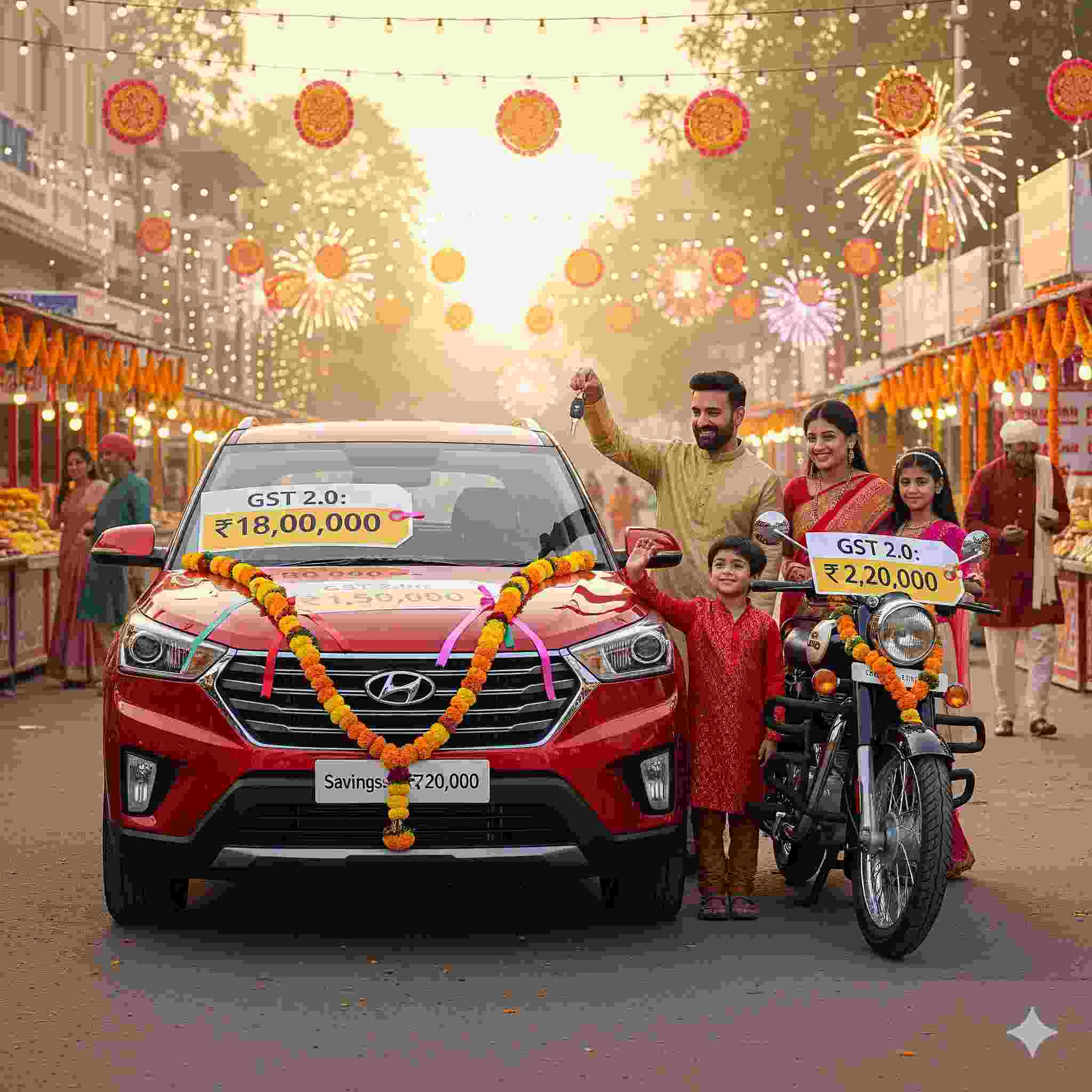You might have heard about GST 2.0 sweeping changes starting September 22, 2025, but one question every prospective buyer is asking: “Will GST 2.0 make my car or bike cheaper?”
Ravi, a 35-year-old banking professional in Delhi, has been saving up for a compact hatchback and is curious if this reform will lower the road tax on that dream car. Rahul, his friend who rides a 125cc commuter bike, wonders if his next two-wheeler will be more affordable.
Let’s break it down to understand how the new GST slabs will affect vehicle prices, who really benefits, who might pay more, and what this means for buyers across India.
For full explanation see GST 2.0 Explained
What Exactly Has Changed Under GST 2.0?
India’s GST law has simplified tax rates into fewer slabs, mostly 5%, 18%, and a special 40% for sin and luxury items. For automobiles, the key changes are:
| Vehicle Category | Old GST Rate | New GST Rate | Effective Date |
|---|---|---|---|
| Small cars (petrol/LPG ≤1200cc, diesel ≤1500cc & ≤ 4000mm length) | 28% | 18% | Sept 22, 2025 |
| Bikes ≤ 350cc | 28% | 18% | Sept 22, 2025 |
| Electric Vehicles | 5% | 5% | No change |
| Larger cars (above limits) | 28% + cess | 40% (flat) | Sept 22, 2025 |
| Motorcycles > 350cc | 28% + cess | 40% | Sept 22, 2025 |
| Three-wheelers | 28% | 18% | Sept 22, 2025 |
The biggest winners are small cars, entry-level motorcycles, and three-wheelers, all moving down from 28% GST to 18%, providing real price relief. However, luxury SUVs, bigger bikes, and premium vehicles now attract a flat 40% GST without separate compensation cess.
See: From Shampoo to Cement: What else Gets Cheaper After GST 2.0
What Does This Mean For You?
For Small Car Buyers:
Ravi’s Maruti Swift or Hyundai i20 falls under the lower slab—18% GST. Earlier, the total tax on the car was 28% plus a compensation cess of around 17-22%, making the effective tax close to 50%. Now, with a flat 18% GST and no cess, the sticker price should come down significantly.
Example impact:
- On a ₹7 lakh compact car, this could mean savings of ₹1.5-2 lakhs on the total price.
- Your EMI burden will reduce, making monthly payments lighter.
For Bike Owners & Buyers:
Rahul’s popular commuter bike, say a Hero Splendor 350cc, is now under the 18% GST slab if the engine is 350cc or less. But if he were eyeing a Royal Enfield Classic 500 or KTM Duke 390, those bikes fall into the luxury category and face a tax hike to 40%.
Key takeaways:
- Bikes ≤ 350cc: Cheaper by about 10% GST cut
- Bikes > 350cc: More expensive with 40% flat GST
- Electric bikes remain at 5% GST
For Commercial Buyers & Three-Wheelers:
If you own or plan to buy a taxi or an auto-rickshaw, good news — GST comes down from 28% to 18%. This could lower operating costs for drivers and small commercial vehicle owners.
Real-Life Scenario: Buying a Car and Bike
Rahul, the IT Professional:
He plans to buy a new Hyundai Venue (petrol, ≤1200cc, length under 4 meters). The GST cut means his purchase price will drop from around ₹9 lakh to closer to ₹7.5 lakh, saving ₹1.5 lakh upfront. His EMI reduces and he can maybe upgrade features within the same budget now.
Amit, the Small Business Owner:
Amit wants to buy a Bajaj Pulsar (₹1.2 lakh) for daily commuting and deliveries. The bike faces 18% GST now instead of 28%. The new rate means a saving of about ₹12,000—substantial for a small entrepreneur aiming to expand his business.
What About Luxury Vehicles?
Though taxes on luxury cars and big bikes have increased to 40%, note this rate includes the compensation cess that earlier bumped tax nearly to 50%. This move simplifies tax calculations and is less of a price shock despite the rate rise.
Affected vehicles include:
- SUVs like Hyundai Creta, Kia Seltos, Tata Harrier
- Premium bikes like Royal Enfield 500cc+ models, KTM 390+ cc, Harley Davidson
Key Points for Buyers and Investors
- Expect price drops on entry-level cars and bikes, mostly in the INR 1-12 lakh range.
- Higher tax for luxury vehicles may shift demand to mid-segment models.
- EMIs and registration expenses reduce for lower slab vehicles.
- Commercial vehicle operators benefit from lower GST, easing logistics.
- EVs get a flat 5% GST rate, supporting green mobility policies.
FAQs
1. When will the new GST rates apply?
From September 22, 2025, for all vehicles except tobacco and luxury alcohol products.
2. Will I save money buying a new small car or bike?
Yes, the GST cut from 28% to 18% means a direct price reduction of roughly 10–15% on most smaller vehicles.
3. Does this benefit used vehicle buyers?
GST applies only on new vehicle sales, so used cars and bikes are unaffected.
4. What about electric cars and bikes?
Electric vehicles continue to attract a GST rate of just 5%, unchanged from before.
5. Why did GST increase on luxury vehicles?
The goal is to use higher taxes on luxury items to subsidize relief for popular, affordable vehicles used by most Indians.
Conclusion
GST 2.0 presents a welcome relief for Indian consumers, especially those eyeing new small cars or motorcycles. With tax reductions on affordable vehicles and lowered costs for commercial autos, this reform is set to boost vehicle ownership across India. However, luxury vehicles and big bikes become costlier with a higher flat tax.
If you or someone you know is planning to buy a new car or bike, keep the new GST slabs in mind to time your purchase smartly. Share this post with friends who are car-hunting or bike shopping.
